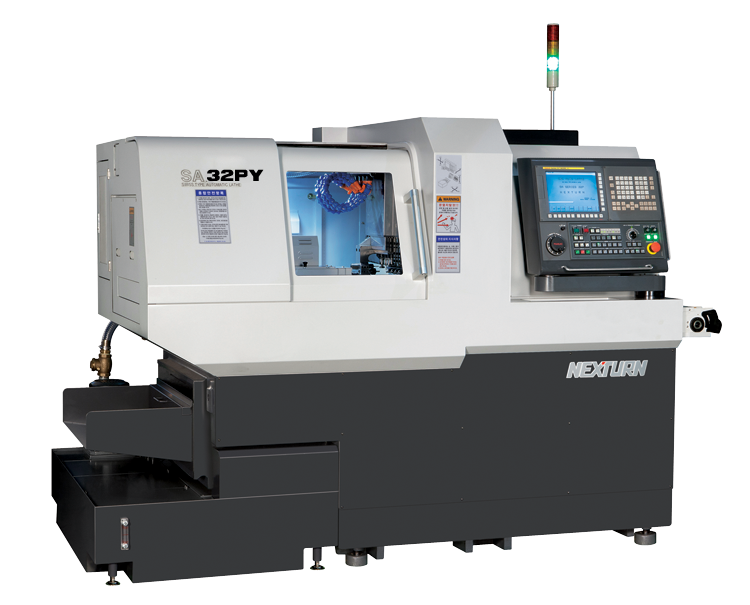Nexturn SA(PYII) 8-Axis Swiss Lathe Series
The Nexturn SA(PYII) Swiss CNC lathe series are our high-level machines featuring an exchangeable guide bushing Removing the guide bushing for short parts keeps remnant length to a minimum with a maximum turn length of 60mm, and allows the use of non-ground bar stock. The guide bushing, for longer parts utilizing ground bar stock, allows maximum turning length up to 210mm. The PYII series features 8 axes and 4 different models from 20mm to 38mm bar capacity.
The SA(PYII) features a total of 8 axes (Z1, X1, Y1, Z2, X2, Y2, C1, and C2) and up to 27 total tools. Bar capacity is 20/26/32/38mm. High precision integral motor spindles on both main and sub provide excellent precision and fast cycle times.
The machine is built for rigidity, accuracy, reliability, and ease of use. The highly rigid one-piece cast iron machine bed is designed using FEM software. Powerful motors for both turning and milling deliver outstanding machining capability. The use of ultra-precision pre-tensioned ballscrews and LM guides produce high accuracy. High speed positioning of 1260”/min. reduces cycle times. A sliding operators door, as opposed to a lift up style door, provides easy access to the machining area and is drip free.
Specifications
| Item / Model |
SA-20PYII
Request a Quote |
SA-32PYII
Request a Quote |
SA-38PYII
Request a Quote |
|---|---|---|---|
|
FREE TRACER 20 Bar Feeder |
FREE TRACER 32V Bar Feeder |
FREE TRACER 51V Bar Feeder Package | |
|
Number of Axes |
8 |
8 |
8 |
|
Number of Channels |
2 |
2 |
2 |
|
Bar Capacity |
20 mm |
32 mm |
38 mm |
|
Guide Bushing Type |
Exchangeable |
Exchangeable |
Exchangeable |
|
Main Spindle (Integral) |
5 HP / 10,000 RPM |
10 HP / 8,000 RPM |
10 HP / 8,000 RPM |
|
Sub Spindle (Integral) |
3 HP / 8,000 RPM |
5 HP / 8,000 RPM |
5 HP / 8,000 RPM |
|
Max. Turning Length |
8″ / 2.36″ |
8″ / 3.15″ |
8″ / 3.15″ |
|
Total Tools |
27 |
25 |
24 |
|
Fixed Tools (Front/Rear) |
12 / 4 |
12 / 4 |
11 / 4 |
|
Live Tools (Front/Rear) |
7 / 4 |
5 / 4 |
5 / 4 |
|
Live Tools |
3 HP / 6,000 RPM |
3 HP / 6,000 RPM |
3 HP / 6,000 RPM |
|
B Axis |
N/A |
N/A |
N/A |
|
C Axis Contouring |
Main/Sub |
Main/Sub |
Main/Sub |
|
CNC Control |
FANUC OiTF |
FANUC OiTF |
FANUC OiTF |
|
Weight |
7,260 lbs. |
7,700 lbs. |
7,920 lbs. |
FAQs
When should a shop consider buying a CNC Swiss lathe?
If your shop runs high volume parts and needs the ability to run lights out, then a Swiss lathe may be a great option. Changeover on a Swiss lathe is minimal, especially when running a family group of similar style parts together. With the exception of changing out collets, an operator can load a new program and start cutting in typically a few hours at the most. Components machined on a Swiss lathe are also more reliably turned than with a conventional lathe and can therefore meet high accuracy specifications. This increased accuracy means that switching to a Swiss from a conventional lathe can reduce costs related to returned parts as well as delayed lead time and retooling costs.
What if I don’t want to use a guide bushing on a Swiss lathe?
The rigidity offered by the guide bushing makes it one of the best attributes of a Swiss lathe. If a shop doesn’t see the need for the guide bushing, then they are better off buying a conventional lathe for less money.
How many axes does a CNC Swiss lathe have?
The number of axes varies depending on the options. For instance, the SA(PYII) features a total of 8 axes (Z1, X1, Y1, Z2, X2, Y2, C1, and C2). Nexturn, and other brands of Swiss lathes, have options for a Y axis on the backside. Other models also have B-axes for use with angular drilling tools. Most conventional Swiss machines have anywhere from 7-9 axes.
What applications and industries are Swiss lathes best suited for?
Swiss machining has become the process of choice for a wide range of applications and industries that require accuracy, quick production times, and a reduction in variable costs. This includes turning applications with live tooling for cross-holes using milling, drilling, and or tapping, as well as parts that require high precision in high volume. Industries that require high precision metal machining include aerospace, defense, electronics, medical, and automotive.


